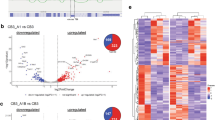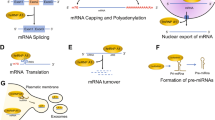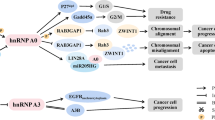Abstract
cIAP1 is an important member of the inhibitor of apoptosis family of proteins and is involved in the regulation of the NF-κB-signalling pathway downstream of the TNF receptor. We report here that UV irradiation leads to downregulation of cIAP1 expression because of enhanced cIAP1 mRNA destabilization. An AU-rich element located within the 3′ untranslated region of cIAP1 mRNA is sufficient to mediate cIAP1 mRNA instability. Furthermore, we have identified hnRNP A1 as a cIAP1 3′UTR-binding protein. hnRNP A1 is a primarily nuclear protein, but accumulates in the cytoplasm after exposure of cells to UV irradiation. Indeed, we find that hnRNP A1 enhances the destabilization of cIAP1 mRNA during UV irradiation. Moreover, siRNA-mediated knockdown of hnRNP A1 restores cIAP1 levels and prevents UV irradiation-induced activation of the NF-κB signal transduction pathway, suggesting that hnRNP A1 is an essential post-transcriptional modulator of cIAP1 expression, and thus cIAP1 activity.
Similar content being viewed by others
Log in or create a free account to read this content
Gain free access to this article, as well as selected content from this journal and more on nature.com
or
Abbreviations
- ARE:
-
AU-rich element
- CAT:
-
chloramphenicol acetyl transferase
- hnRNP A1:
-
heterogeneous ribonucleoprotein A1
- IAP:
-
inhibitor of apoptosis
- IRES:
-
internal ribosome entry site
- NEO:
-
neomycin phosphotransferase
- NF-κB:
-
nuclear factor kappa B
- RING:
-
really interesting new gene
- TNFα:
-
tumour necrosis factor α
- UTR:
-
untranslated region
- UVR:
-
UV irradiation
References
Salvesen GS, Duckett CS . Apoptosis: IAP proteins: blocking the road to death's door. Nat Rev Mol Cell Biol 2002; 3: 401–410.
Vaux DL, Silke J . IAPs, RINGs and ubiquitylation. Nat Rev Mol Cell Biol 2005; 6: 287–297.
Eckelman BP, Salvesen GS, Scott FL . Human inhibitor of apoptosis proteins: why XIAP is the black sheep of the family. EMBO Rep 2006; 7: 988–994.
Rothe M, Pan MG, Henzel WJ, Ayres TM, Goeddel DV . The TNFR2-TRAF signaling complex contains two novel proteins related to baculoviral inhibitor of apoptosis proteins. Cell 1995; 83: 1243–1252.
Li X, Yang Y, Ashwell JD . TNF-RII and c-IAP1 mediate ubiquitination and degradation of TRAF2. Nature 2002; 416: 345–347.
Vince JE, Wong WW, Khan N, Feltham R, Chau D, Ahmed AU et al. IAP antagonists target cIAP1 to induce TNF alpha-dependent apoptosis. Cell 2007; 131: 682–693.
Petersen SL, Wang L, Yalcin-Chin A, Li L, Peyton M, Minna J et al. Autocrine TNF alpha signaling renders human cancer cells susceptible to Smac-mimetic-induced apoptosis. Cancer Cell 2007; 12: 445–456.
Varfolomeev E, Blankenship JW, Wayson SM, Fedorova AV, Kayagaki N, Garg P et al. IAP Antagonists Induce autoubiquitination of c-IAPs, NF-kappaB Activation, and TNFalpha-Dependent Apoptosis. Cell 2007; 131: 669–681.
Wang CY, Mayo MW, Korneluk RG, Goeddel DV, Baldwin Jr AS . NF-kappaB antiapoptosis: induction of TRAF1 and TRAF2 and c-IAP1 and c-IAP2 to suppress caspase-8 activation. Science 1998; 281: 1680–1683.
Conze DB, Albert L, Ferrick DA, Goeddel DV, Yeh WC, Mak T et al. Posttranscriptional downregulation of c-IAP2 by the ubiquitin protein ligase c-IAP1 in vivo. Mol Cell Biol 2005; 25: 3348–3356.
Warnakulasuriyarachchi D, Ungureanu NH, Holcik M . The translation of an antiapoptotic protein HIAP2 is regulated by an upstream open reading frame. Cell Death Differ 2003; 10: 899–904.
Warnakulasuriyarachchi D, Cerquozzi S, Cheung HH, Holcik M . Translational induction of the inhibitor of apoptosis protein HIAP2 during endoplasmic reticulum stress attenuates cell death and is mediated via an inducible internal ribosome entry site element. J Biol Chem 2004; 279: 17148–17157.
Yoshimura FK, Luo X, Zhao X, Gerard HC, Hudson AP . Up-regulation of a cellular protein at the translational level by a retrovirus. Proc Natl Acad Sci USA 2008; 105: 5543–5548.
Ungureanu NH, Cloutier M, Lewis SM, de Silva N, Blais JD, Bell JC et al. Internal ribosome entry site-mediated translation of Apaf-1, but not XIAP, is regulated during UV-induced cell death. J Biol Chem 2006; 281: 15155–15163.
Kim JH, Paek KY, Ha SH, Cho S, Choi K, Kim CS et al. A cellular RNA-binding protein enhances internal ribosomal entry site-dependent translation through an interaction Downstream of the hepatitis C virus polyprotein initiation codon. Mol Cell Biol 2004; 24: 7878–7890.
Bonnal S, Pileur F, Orsini C, Parker F, Pujol F, Prats AC et al. Heterogeneous nuclear ribonucleoprotein A1 is a novel internal ribosome entry site trans-acting factor that modulates alternative initiation of translation of the fibroblast growth factor 2 mRNA. J Biol Chem 2005; 280: 4144–4153.
Lewis SM, Veyrier A, Hosszu Ungureanu N, Bonnal S, Vagner S, Holcik M . Subcellular relocalization of a trans-acting factor regulates XIAP IRES-dependent translation. Mol Biol Cell 2007; 18: 1302–1311.
Cammas A, Pileur F, Bonnal S, Lewis SM, Leveque N, Holcik M et al. Cytoplasmic relocalization of heterogeneous nuclear ribonucleoprotein A1 controls translation initiation of specific mRNAs. Mol Biol Cell 2007; 18: 5048–5059.
van der Houven van Oordt W, Diaz-Meco MT, Lozano J, Krainer AR, Moscat J, Caceres JF . The MKK(3/6)-p38-signaling cascade alters the subcellular distribution of hnRNP A1 and modulates alternative splicing regulation. J Cell Biol 2000; 149: 307–316.
Allemand E, Guil S, Myers M, Moscat J, Caceres JF, Krainer AR . Regulation of heterogenous nuclear ribonucleoprotein A1 transport by phosphorylation in cells stressed by osmotic shock. Proc Natl Acad Sci USA 2005; 28: 28.
Bender K, Gottlicher M, Whiteside S, Rahmsdorf HJ, Herrlich P . Sequential DNA damage-independent and -dependent activation of NF-kappaB by UV. EMBO J 1998; 17: 5170–5181.
Khabar KS, Bakheet T, Williams BR . AU-rich transient response transcripts in the human genome: expressed sequence tag clustering and gene discovery approach. Genomics 2005; 85: 165–175.
Chen CY, Shyu AB . AU-rich elements: characterization and importance in mRNA degradation. Trends Biochem Sci 1995; 20: 465–470.
Mayeda A, Krainer AR . Regulation of alternative pre-mRNA splicing by hnRNP A1 and splicing factor SF2. Cell 1992; 68: 365–375.
Hamilton BJ, Nagy E, Malter JS, Arrick BA, Rigby WF . Association of heterogeneous nuclear ribonucleoprotein A1 and C proteins with reiterated AUUUA sequences. J Biol Chem 1993; 268: 8881–8887.
Pende A, Contini L, Sallo R, Passalacqua M, Tanveer R, Port JD et al. Characterization of RNA-binding proteins possibly involved in modulating human AT(1) receptor mRNA stability. Cell Biochem Funct 2008; 26: 493–501.
Christian K, Lang M, Maurel P, Raffalli-Mathieu F . Interaction of heterogeneous nuclear ribonucleoprotein A1 with cytochrome P450 2A6 mRNA: implications for post-transcriptional regulation of the CYP2A6 gene. Mol Pharmacol 2004; 65: 1405–1414.
Glisovic T, Ben-David Y, Lang MA, Raffalli-Mathieu F . Interplay between hnRNP A1 and a cis-acting element in the 3′ UTR of CYP2A5 mRNA is central for high expression of the gene. FEBS Lett 2003; 535: 147–152.
Meisner NC, Hackermuller J, Uhl V, Aszodi A, Jaritz M, Auer M . mRNA openers and closers: modulating AU-rich element-controlled mRNA stability by a molecular switch in mRNA secondary structure. Chembiochem 2004; 5: 1432–1447.
Schenkel J, Sekeris CE, Alonso A, Bautz EK . RNA-binding properties of hnRNP proteins. Eur J Biochem 1988; 171: 565–569.
Ding J, Hayashi MK, Zhang Y, Manche L, Krainer AR, Xu RM . Crystal structure of the two-RRM domain of hnRNP A1 (UP1) complexed with single-stranded telomeric DNA. Genes Dev 1999; 13: 1102–1115.
Burd CG, Dreyfuss G . RNA binding specificity of hnRNP A1: significance of hnRNP A1 high-affinity binding sites in pre-mRNA splicing. EMBO J 1994; 13: 1197–1204.
Xu RM, Jokhan L, Cheng X, Mayeda A, Krainer AR . Crystal structure of human UP1, the domain of hnRNP A1 that contains two RNA-recognition motifs. Structure 1997; 5: 559–570.
Pinol-Roma S, Dreyfuss G . Shuttling of pre-mRNA binding proteins between nucleus and cytoplasm. Nature 1992; 355: 730–732.
Guil S, Long JC, Caceres JF . hnRNP A1 relocalization to the stress granules reflects a role in the stress response. Mol Cell Biol 2006; 26: 5744–5758.
Tan HT, Zubaidah RM, Tan S, Hooi SC, Chung MC . 2-D DIGE analysis of butyrate-treated HCT-116 cells after Enrichment with heparin affinity chromatography. J Proteome Res 2006; 5: 1098–1106.
Rehemtulla A, Hamilton CA, Chinnaiyan AM, Dixit VM . Ultraviolet radiation-induced apoptosis is mediated by activation of CD-95 (Fas/APO-1). J Biol Chem 1997; 272: 25783–25786.
Deng J, Harding HP, Raught B, Gingras AC, Berlanga JJ, Scheuner D et al. Activation of GCN2 in UV-irradiated cells inhibits translation. Curr Biol 2002; 12: 1279–1286.
Wu S, Hu Y, Wang J-L, Chatterjee M, Shi Y, Kaufman RJ . Ultraviolet light inhibits translation through activation of the unfolded protein response kinase PERK in the lumen of the endoplasmic reticulum. J Biol Chem 2002; 277: 18077–18083.
Van Eden ME, Byrd MP, Sherrill KW, Lloyd RE . Translation of cellular inhibitor of apoptosis protein 1 (c-IAP1) mRNA is IRES mediated and regulated during cell stress. RNA 2004; 10: 469–481.
Holcik M, Lefebvre CA, Hicks K, Korneluk RG . Cloning and characterization of the rat homologues of the inhibitor of apoptosis protein 1, 2, and 3 genes. BMC Genomics 2002; 3: 5–10.
Acknowledgements
This work was supported by a discovery grant from the National Sciences and Engineering Research Council of Canada (NSERC). J.C. is the recipient of Canada Research Chair (Tier 2) in RNA Metabolism. I.G. is supported by a scholarship from Fonds pour la Recherche en Santé du Québec (FRSQ). T.E.G. is supported by the Frederick Banting and Charles Best Canada Graduate Scholarships Doctoral Award. M.H. is the CHEO Volunteer Association Endowed Scholar
Author information
Authors and Affiliations
Corresponding author
Additional information
Edited by J Silke
Supplementary Information accompanies the paper on Cell Death and Differentiation website (http://www.nature.com/cdd)
Rights and permissions
About this article
Cite this article
Zhao, T., Graber, T., Jordan, L. et al. hnRNP A1 regulates UV-induced NF-κB signalling through destabilization of cIAP1 mRNA. Cell Death Differ 16, 244–252 (2009). https://doi.org/10.1038/cdd.2008.146
Received:
Revised:
Accepted:
Published:
Issue date:
DOI: https://doi.org/10.1038/cdd.2008.146
Keywords
This article is cited by
-
Anti-proliferation and pro-apoptosis effects of miR-582-5p in chronic lymphocytic leukemia via targeting HNRNPA1 and suppression of NF-κB
Molecular & Cellular Toxicology (2021)
-
Long noncoding RNA CRNDE stabilized by hnRNPUL2 accelerates cell proliferation and migration in colorectal carcinoma via activating Ras/MAPK signaling pathways
Cell Death & Disease (2017)
-
Decreased eIF3e/Int6 expression causes epithelial-to-mesenchymal transition in breast epithelial cells
Oncogene (2013)
-
HuR–hnRNP interactions and the effect of cellular stress
Molecular and Cellular Biochemistry (2013)
-
Distinct roles for the cellular inhibitors of apoptosis proteins 1 and 2
Cell Death & Disease (2011)



